Colorful winter-hardy hibiscus hybrids continue trek to consumer gardens
First varieties could be available in spring 2018
Writer: Kay Ledbetter, 806-677-5608, [email protected]
Contact: Dr. Dariusz Malinowski, 940-552-9941, [email protected]
VERNON – The winter-hardy hibiscus breeding program led by Dr. Dariusz Malinowski, a Texas A&M AgriLife Research forage agronomist and plant breeder at Vernon, is in the spotlight again.
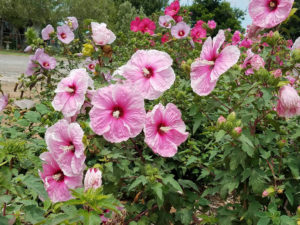
“We are about to conclude our seventh breeding season, and we have another 20 or so unique hibiscus hybrids that may beautify gardens across the U.S. one day,” Malinowski said.
To date, he said the breeding team has disclosed about 220 hibiscus breeding lines to Texas A&M University Office of Commercialization, and the first plants may be for sale in spring 2018.
“It is still quite a long way from when we identify a hybrid with a unique flower color or shape to the moment you can actually purchase the plant in stores,” Malinowski said, explaining commercial partners usually require a two- to three-year evaluation period to test the hybrids at their facilities across the country, during which time they might request modifications.
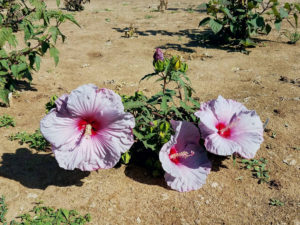
“While working with our industry partners, we have learned that, in contrast to interests of everyday gardeners and plant enthusiasts, the unique flower colors or their shapes very rarely are deciding criteria for commercialization,” he said. “Large-scale nurseries put their focus on plant shape, branching characteristics and other attributes important to the production process.”
Malinowski said while he knows it takes time, he is anxious to share the many different flower colors, sizes and shapes they have developed, as well as a variety of leaf colors, with home gardeners.
The winter-hardy hibiscus breeding program at Vernon was the first to bring a totally new set of colors in these plants, including the illusive blue-colored flowers, maroon, magenta, a number of dual and triple-colored flowers, plus a range of new flower shapes never seen before in this species, Malinowski said.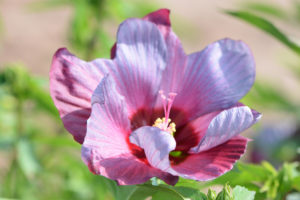
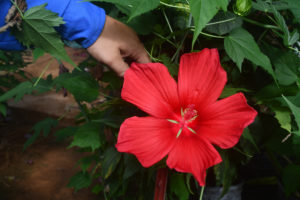
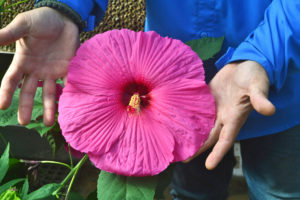
He and his two colleagues, the late Steve Brown, former director of Texas Foundation Seed Service, and Dr. Bill Pinchak, AgriLife Research animal nutritionist at Vernon, started the program in 2008 in their own gardens.
“Our first idea early in the development of the program was to create as much diversity in our hybrids as possible,” he said.
They chose to hybridize together many native and cultivated hibiscus species to bring new genetics into the cultivated hibiscus moscheutos species, Malinowski said.
“I was fascinated with the early work on hibiscus hybridization by the late Georgia Bost of Waller, who believed intensive interspecific hybridization of winter-hardy hibiscus would eventually result in the appearance of new colors and color combinations as it was achieved in tropical hibiscus (H. rosa-sinensis) breeding over the past century,” he said.
“We did not have to wait long. We started to see novel colors in our hybrids after four to five years of interspecific hybridization.”
Malinowski said they even saw flower color combinations and shapes that almost perfectly resemble those in tropical hibiscus.
“We now have 12 winter-hardy hibiscus hybrids with flowers looking almost identical to those of tropical hibiscus cultivars,” he said.
The winter-hardy hibiscus breeding program became an official part of the AgriLife Research-Vernon strategic plan in 2010. Since then, Malinowski and his team have evaluated over 12,000 hybrids.
“Our main constraint is the lack of space and supporting infrastructure,” he said. “But with the anticipated commercialization of the hybrids, we hope to modernize our operations to make the breeding efforts more efficient.”
It is expected the first few lines, including a couple with blue flowers, will be available on the national market in spring 2018.
“We have to adjust our breeding efforts to the requirements of the industry, i.e., by developing smaller, more compact plants that better fit limited spaces on the patios or in small city gardens,” Malinowski said.

“We still want our novel colors to be incorporated into the plants, however this will require additional years of breeding and eventually delay introduction of the fantastic colors to our gardens,” he said
This season, Malinowski discovered a mutation on one of his experimental plants that resulted in variegated leaves.
“This is a totally new venue for us to introduce a very rare trait not previously reported in winter-hardy hibiscus,” he said. “I can already envision the multicolored leaves combined with our novel flower colors.”
Malinowski and his two support staff members, Bryan Hope and Gordon Raymos, have been trying to introduce even more genetic variability into their winter-hardy hibiscus hybrids.
“Our new goal is to develop flowers with yellow and orange colors,” he said. “This will require some genetic input from distantly related hibiscus species that already have such flower pigments. Our hybrids are not genetically modified. We only help nature create new gene combinations resulting in novel hybrids.”
A number of their hibiscus hybrids are currently under evaluation by industry partners.
“We have decided to modify our breeding objectives to better meet the expectations of big box plant producers,” Malinowski said. “Let’s just hope they can quickly achieve their new goals so we can soon enjoy the flowers in our gardens.”


